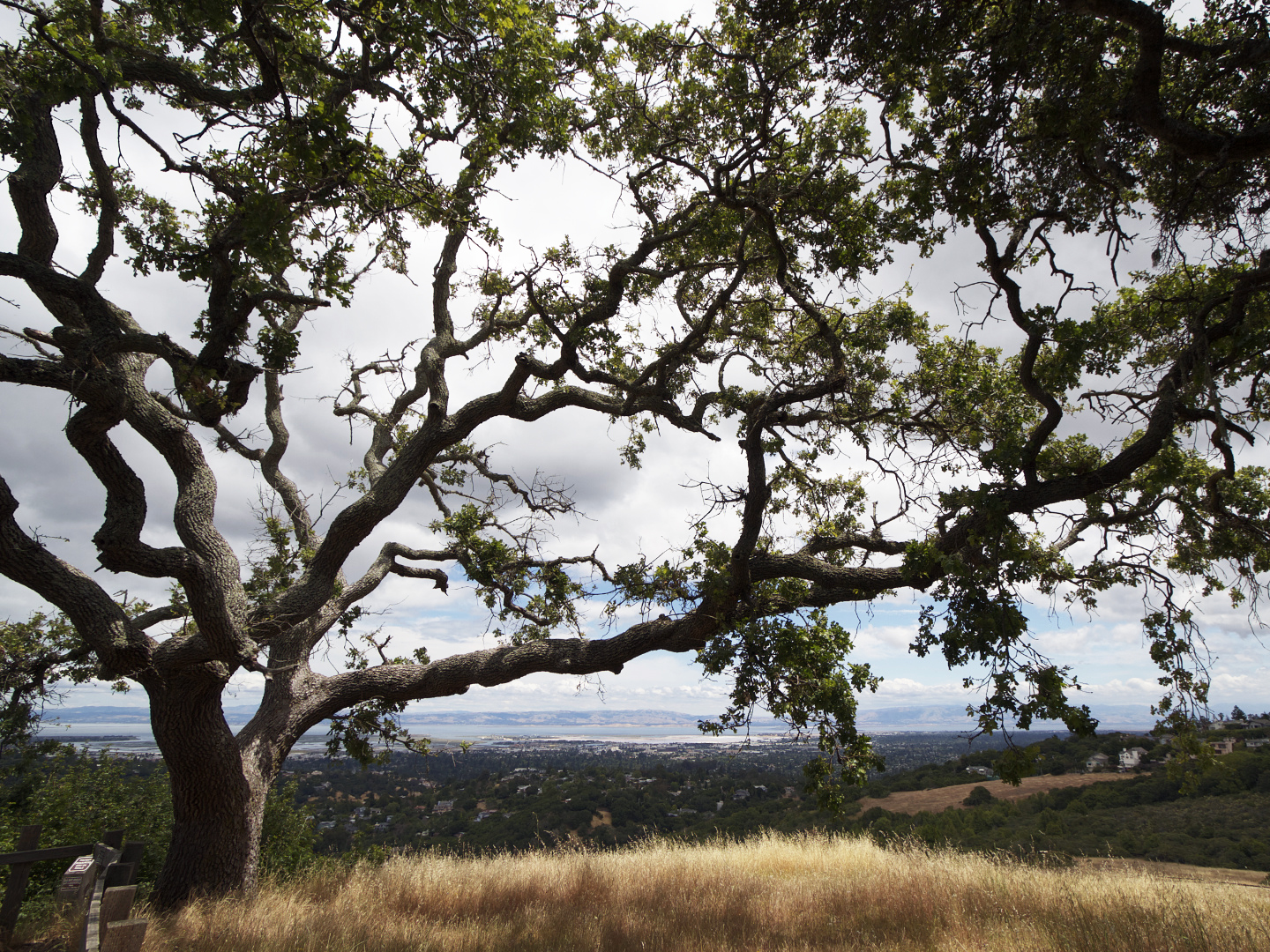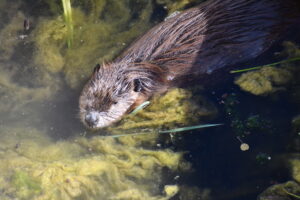
After some 40 years hiking the hills of the Bay Area, I should have known better than to follow Dr. Stuart Weiss off the trail into the grasslands of Edgewood Natural Preserve on a warm morning in June. Tucking our pant legs into our socks to keep out ticks seemed like a good idea at the time. But it also guaranteed a painstaking post-hike session to extract the multiple grass seeds and burrs out of said socks. Mostly non-native grass seeds, I should add.
But if Weiss and his colleagues at the nonprofit Friends of Edgewood Natural Preserve have their way, in the not-too-distant future those sock-seeking grass seeds will have a much higher quotient of natives. And that will mean, according to Weiss, a much higher “coefficient of beauty” for the preserve’s grasslands. At least that’s their goal.
Edgewood County Park and Natural Preserve is a 467-acre open space on the San Francisco Peninsula near Redwood City that was destined to become a public golf course until a group of open space advocates and native plant nerds came together in the early 1980s to convince the San Mateo Board of Supervisor to alter that plan. Weiss’ connection to Edgewood predates that battle, going back to his days in the late 1970s and early 1980s as an undergraduate at Stanford studying under renowned ecologist Paul Ehrlich. He was drawn to Edgewood, then an undeveloped parcel of open space owned by the state, because of its proximity to Stanford, its mix of habitats (grasslands, oak woodland, chaparral, and riparian), and in particular, its 100 acres of serpentine grasslands, which produced dramatic displays of native wildflowers and hosted a number of rare and endemic species, in particular a population of Bay checkerspot butterflies. It’s also what drew the plant lovers who organized to defeat the golf course proposal and get the board of supervisors to declare the place a park and preserve in 1993. With that, the loose “Save Edgewood” coalition morphed into the Friends of Edgewood, with a mission to care for the property that had just been saved. And Weiss, now the chief scientist at Creekside Center for Earth Observation, has stayed involved every step of the way.
This fall, the Friends are celebrating their 25th anniversary by raising the bar on themselves and the park with the rollout of Project 467 (so called because of the Preserve’s acreage). This is an ambitious framework for restoring all of Edgewood’s native ecosystems, building on a quarter century of volunteer efforts to remove invasive nonnatives and begin restoration of the signature serpentine grasslands. On this warm late spring day, Dr. Weiss has invited me to check out the early stages of one of the four components of Project 467, the “Green Grass project” which is aimed at restoring the preserve’s grasslands, including the non-serpentine grasslands.
At first glance, at this time of year, the preserve’s non-serpentine grasslands appear to be an undifferentiated tawny blanket of thigh-high grass stalks going to seed. But once we venture into them, Weiss begins to point out the native bunchgrasses in the sea of wild oats, ripgut brome, and other nonnatives. First he shows me stalks of Danthonia californica, or California oat grass. Then he proudly shows off the more delicate stalks and finely etched seed heads of Stipa lepida, or foothill needlegrass, first cousin of purple needlegrass (Stipa pulchra), the California state grass, which he finds just a few yards away, in one of the 40 five-meter-radius plots established to survey and track the composition of these non-serpentine grasslands.
As Weiss concedes, referring to the native grasses, “There’s not much of it here.” “But,” he stresses, “the point is that it IS here.” He estimates that natives make up about 10 percent of the grasses at Edgewood, and these, Weiss says, constitute the essential building blocks for restoring the grasslands; all they need is a little help from their Friends. The challenge that Weiss and the Friends have set for themselves is to develop a methodology for knocking back the nonnatives—and the suffocating thatch that forms on top of the soil when they die back in the summer—for a few years to give the native grasses and showy perennial forbs (such as lupine, mule’s ears, and brodiaea) a chance to reestablish themselves.
Sidebar: Derailing the PG&E Pipeline
The three-part mission of the Friends of Edgewood is to “Protect, Restore, and Educate” on behalf of Edgewood Natural Preserve. And while most of the protection part was accomplished by the Save Edgewood Coalition back in the 1980s, that work is never completely done.
Following on the heels of the deadly PG&E gas pipeline explosion in San Bruno in 2010, the company was ordered to institute more rigorous regular testing of all its pipelines. Two of those pipelines pass underground along the western portion of Edgewood Preserve. The oldest of these pipelines was installed in 1936 and is of a smaller diameter than other pipelines. PG&E’s current pipeline testing equipment will not work in this smaller pipeline, so in 2013, the company proposed to replace the old pipeline with a new larger one.
Once the Friends of Edgewood caught wind of this plan, which threatened massive disruption of the sensitive serpentine grasslands that they had expended so much effort to restore, they immediately went into action. They assembled a coalition of local conservation organizations, including the Committee for Green Foothills and the Santa Clara Valley chapter of the California Native Plant Society, to convince PG&E to abandon the project or consider alternatives. Subsequently, the Friends discovered that PG&E had studied three other possible routes for the pipeline, including one that skirted the preserve altogether. Several meetings were held with PG&E officials, county officials, the Friends and their colleagues, and in August 2017, PG&E agreed not to pursue the pipeline replacement project for the time being, and to instead utilize alternative methods to ensure the integrity of the existing pipeline. According to Bill Korbholz, president of the Friends of Edgewood, “It was a remarkable achievement for our little preserve to get this large corporation to back down. The impact of both CGF and CNPS was huge. It was a great example of how the environmental community can come together to be effective.”
Over their first 25 years, the volunteers mobilized by Friends of Edgewood and the California Native Plant Society and supported by San Mateo County Parks have done a remarkable job of weeding out large invasive nonnative plants such as yellow star thistle, teasel, and bristly ox-tongue. By staying on task year after year, they have virtually eliminated these persistent invaders from the preserve. But as Friends president Bill Korbholz explained to me, hand removal of nonnative annual grasses over several hundred acres is just not feasible. So as a first stage of the Green Grass Project, Weiss is going to investigate several methods to get the job done. Of course, in the days before European settlement, California tribes would have used fire to maintain the health of the grasslands. Weiss and others would love to use prescribed burning, but with suburban housing on three sides and busy I-280 on the other, that’s largely out of the question here.
Weiss leads me over to another plot where he experimented with one such treatment method (HMO, or “hydro-mechanical obliteration,” which utilizes highly pressurized jets of water) six years ago. The treatment was followed by seeding of natives to take advantage of the newly opened ground. Now six years later, while there are plenty of nonnative grasses here, I’m immediately struck by the impressive number of white-topped stalks of yarrow (Achillea millefolium) rising above the grasses. And a little lower down, semi-hidden in the grasses are equally impressive patches of the bright pink blooms of the native Clarkia rubicunda, or farewell-to-spring. We’ve seen these in some of the other plots as well, but not in such density or profusion. And the same goes for the bright yellow mariposa lilies (Calochortus luteus) and the royal blue blooms of Brodiaea elegans. Weiss estimates that the native cover here is about 30 percent, not bad given the absence of follow-up treatment or maintenance that will be an essential component of this new project.
According to Weiss, this variety of colors we’re seeing here isn’t a random accident. He has a theory – not scientifically proven – that a “high beauty coefficient” correlates with high biodiversity. Or perhaps the other way around. That is, having a variety of colors (and shapes) in the flowering vegetation signals biodiversity, and it is important not just for aesthetics, but to ensure the presence of a variety of pollinators attracted to different colors and shapes of blooms. Weiss opines that our sense of aesthetics is linked to an innate appreciation for diversity. And his goal at Edgewood isn’t just to increase biodiversity for its own sake. It’s to make the place pleasing – if not downright irresistible – to humans, who will walk the trails and have their hiking socks knocked off by the multi-hued splashes of color all around them.
Of course, being a scientist, Weiss can’t resist creating a measurement for this kind of sensual pleasure. He calls it IB– or “I-sub-B”, which stands for either “coefficient of beauty” or, more poetically, “Beauty is in the I/eye of the Beholder.” It works on a scale of 1 to 10, “with 11 being the best,” says Weiss, when we find a particularly dense patch of the yellow lily Calochortus luteus with some of the pink clarkias mixed in. It’s the kind of place where you stop and smile and think “Wow!” Or, if you’re Weiss, you say it out loud, while simultaneously swearing at his iPhone as he tries to enter the exact locations of these patches of native plants into a database he created to help determine which plots to prioritize for which species of plants.
It is perhaps this combination of rigorous science and sensuous appreciation of beauty that make this work at Edgewood so compelling. Weiss is an artist who starts with a deep understanding of his materials and his canvas and then steps back and creates a landscape painting on the largest scale imaginable.
Of course, Weiss can’t, doesn’t, and won’t do it by himself. The other piece of the puzzle at Edgewood, besides the pre-existing plants on that landscape, is the highly-trained and dedicated volunteer corps mobilized by Friends of Edgewood.
One of those volunteers is Perry McCarty. McCarty has lived nearby, in Redwood City, since 1988, but says he’d only been to Edgewood a few times, accompanying his son’s Boy Scout troop, before he retired three years ago from his job as a software engineer at eBay. With his new free time, he decided to start exploring the area more and signed up for one of the Friends’ weekly spring wildflower walks. Seduced by both the landscape and the knowledgeable guide, he signed up for one of the Friends’ more specialized outings, a geology walk led by a geologist who is also a docent. Most of the other participants were docents, and McCarty was intrigued by the opportunity to dig a little deeper. As he said about the possibility of taking the docent training himself, “It didn’t seem too onerous,” so he signed up and started the course in January 2017.
He found that “it’s so much more fun when you’re out there, to be able to see the things and know them and name them, and also see them through their life cycle, starting with the flowers, then recognizing the leaves, and you just become more aware. It’s not just about identifying things, but also learning the bigger scale processes – the plant communities, the soils, the geology, the history – the bigger story of the place.”
The Friends are a pretty busy organization, responsible for staffing the education center (built in 2010 with funds raised through the San Mateo County Parks Foundation), leading over 100 wildflower walks annually, removing invasive plants, annual Sudden Oak Death blitzes, and a lot more. As a member you get exposed to a whole range of projects. One that caught McCarty’s eye was the call for volunteers to count Bay checkerspot butterflies. Which brings us back to Stu Weiss and the origin story of the preserve.

The Bay checkerspot is a medium-sized butterfly with beautifully patterned wings in red, yellow, orange, and black. To host its larvae, the butterfly depends on plants that grow only on shallow serpentine soils, and in particular on California Plantain (Plantago erecta) and purple owl’s clover (Castilleja exserta). The checkerspot population at Edgewood – the sole remaining population in San Mateo County – had been studied by researchers, including Dr. Ehrlich, at Stanford University starting in the 1960s, and when Stuart Weiss did his undergraduate work there, he focused on the Bay checkerspot.
However, by 1980, the populations were in serious decline, so Ehrlich and colleagues prepared an application to the US Fish and Wildlife Service advocating federal protection for the species. In 1987 FWS declared the Bay checkerspot a threatened species, just as the struggle for protecting Edgewood was heating up. Protecting the butterfly, then, became inextricably linked with establishment of the Preserve.
However even with the landscape protected, the checkerspot declined sharply starting in 1998, the victim of what Weiss has dubbed “drive-by extinction.” Weiss’ research showed that exhaust from the cars passing by on the I-280 freeway—on the western edge of the preserve—was depositing unnatural amounts of nitrogen oxides and ammonia on the nutrient-poor serpentine soils, in essence fertilizing them and causing them to become more hospitable to the nonnative grasses which invaded from the surrounding grasslands and overwhelmed the butterfly’s host plants. By 2002, the butterfly had disappeared at Edgewood.
But Weiss and the Friends were not going to take extinction lying down. In 2002, they began the restoration of the serpentine grassland habitat through a combination of hand weeding and mechanical mowing, to knock back the nonnatives. Today, in the spring, the restored area once again boasts large swaths of goldfields and tidy tips and other serpentine-associated wildflowers, including the plantain and the owls clover. With the canvas prepped, in 2007 Weiss began the ambitious and experimental process of restoring the checkerspot to the preserve, transplanting thousands of larvae from the only remaining healthy population, on Coyote Ridge in southern Santa Clara County.
Given the experimental nature of this project, monitoring was absolutely critical, and so the Friends stepped in and organized an impressive corps of butterfly counters who follow a strict survey protocol out on the preserve every single day during the spring butterfly season. In March 2017 McCarty joined this elite volunteer force, and I met him out on the serpentine grasslands on a breezy but sunny April morning as he prepared to do the survey. There are 35 transects, each 50 meters in length, delineated by little red flags. The counter must cover each transect in 90 seconds, counting all the butterflies seen within five meters of the route on either side. On the day I’m with him, McCarty doesn’t see any butterflies. But he’s not too concerned, because it’s still early in the season.
When I reconnect with McCarty at the end of the season he tells me that in all, 43 adult butterflies were counted this spring, down slightly from 47 the year before (and a high of 800 in 2015). I ask Weiss if he’s disappointed with this result. “No, not really,” he says, because for the first time in a number of years, this year he didn’t transplant any larvae from Coyote Ridge. Every year for the previous seven years, Weiss had transplanted several thousand larvae to boost the struggling Edgewood population. But Weiss now believes that the butterflies on Coyote Ridge – which has more than 100 times the suitable habitat as Edgewood—have evolved to disperse over a larger area. While this would be an appropriate strategy for genetic mixing at a larger site, at Edgewood, such dispersal would tend to take an individual to an area without host plants, and hence a reproductive dead end. Weiss thinks that the remaining more “sedentary” checkerspots are likely ones that have made it through that evolutionary bottleneck and are better adapted to thrive and gradually expand in the more limited conditions at Edgewood. So in this context, the stability of the count over the past two years could in fact be a positive development.
Of course, with science this new and untested, there are no guarantees. But it’s exciting stuff, authored by an innovative collaboration of professional and citizen scientists, under the auspices of a completely grassroots volunteer organization born out of a battle to save a small preserve that has transformed itself to do regionally and globally significant landscape stewardship work. And all of the rest of us get to watch – and enjoy – the results. Get ready to have your socks knocked off at a preserve near you. And pitch in if you can!




